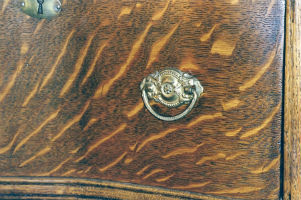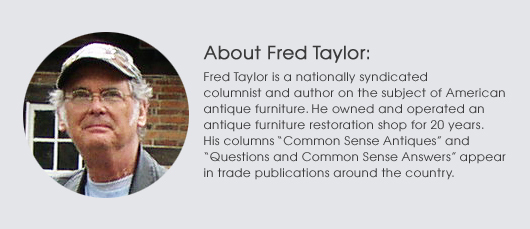
Having discussed context, density and color, we now are down to the last two properties of wood to help made a positive identification.
FIGURE
Figure is the wonderful pattern created by the grain of the wood itself when it is milled into lumber. Some wood is selected especially for its figure such as crotch mahogany or walnut and some is selected for its lack of figure such as rift cut oak, which exhibits nearly perfectly straight lines of grain. But recognizing a distinct figure is difficult to learn. Professional woodworkers spend a lifetime learning to distinguish figure patterns and most people just don’t have that kind of time. Distinguishing between a steeple figure in a piece of maple and one in a piece of similarly colored cherry is tricky business.
The figure in a piece of wood is also greatly influenced by the way in which the original log was cut into workable lumber. A primary example of that is quartersawn oak when compared to flat-cut oak. Cutting an oak log so that modt of the end grain in each board is at an angle of between 60 and 90 degrees to the face of the board produces a piece of highly figured wood caused by the incidental cutting of the medullary rays, the horizontal structures in the wood that connect the soft layer of cambium at the outer edge of the tree to the central core, the pith. These interrupted rays are the “tiger eyes” seen in highly figured oak. The same oak log, on the other hand, produces virtually no such pattern if it is rift cut to produce clear, straight grain patterns or if it is flat cut to produce steeple patterns.

Burl figures are easily distinguishable but it sometimes can be difficult to tell Carpathian elm burl from walnut burl, and some cuts such as “stump” cuts and “butt” cuts are often confused with burls. Crotch cuts are very distinctive but walnut and mahogany cuts are very similar and any wood can be cut to produce that look.
Taking the time and effort to learn wood figures does have an advantage. The figure of the wood is not changed by aging or coloring. Figure is a permanent fixture and practice will teach you to distinguish among different types of wood using this tool.

TEXTURE
Texture deals with the nature of the grain itself, not the pattern of the grain. For our general purpose, texture can be broken into three categories: open, medium and closed. This refers to the width and depth of the grain. Coarse or open grain woods have a texture that can actually be felt with the fingertips. The open grain of oak can be detected by dragging a fingernail across the grain and feeling the resistance as the nail encounters the edge of open grain. Some open grain woods are finished with the grain filled, in which case the grain cannot be felt but it can be seen. The large filled crevices are very apparent. The family of open grained woods includes oak, elm, hickory, pecan, ash, chestnut and elm.
Medium grain woods are those which produce a slightly textured finished surface if the grain is not filled. The open grain of medium woods is very visible but not usually tactile – it cannot be felt with the fingertips. Common woods in this category are walnut, mahogany and butternut, sometimes known as white walnut, although butternut is seldom seen.
The final category of texture is smooth or closed grain. Woods in this category have a tight smooth surface without the individual cracks and crevices of the more open grained varieties and result in a smooth, untextured finish without the need for a paste grain filler. The most frequently encountered woods in this category are maple, birch, cherry, pine, poplar, gum and beech.
To identify a piece of wood, first determine its texture. That usually will eliminate more than half of the most common choices. Then you must learn to identify woods within the categories. No amount of words on a page or pictures in a book will teach you to do that, although there are some excellent references on the subject including a color section in my book How To Be a Furniture Detective.
You must get out there and look at woods, both finished and unfinished, ask questions of people whom you believe to be knowledgeable and compare all the results to your own research.
___
By FRED TAYLOR
Send comments, questions and pictures to Fred Taylor at P.O. Box 215, Crystal River, FL 34423 or email them to him at info@furnituredetective.com. Visit Fred’s newly redesigned website at www.furnituredetective.com and check out the new downloadable “Common Sense Antiques” columns in .pdf format.
His book “How To Be a Furniture Detective” is available for $18.95 plus $3 shipping. Send check or money order for $21.95 to Fred Taylor, P.O. Box 215, Crystal River, FL 34423.
Fred and Gail Taylor’s DVD, “Identification of Older & Antique Furniture” ($17 + $3 S&H) is also available at the same address. For more information call 800-387-6377 (9 a.m.-4 p.m. Eastern, M-F only), fax 352-563-2916, or info@furnituredetective.com. All items are also available directly from his website.




